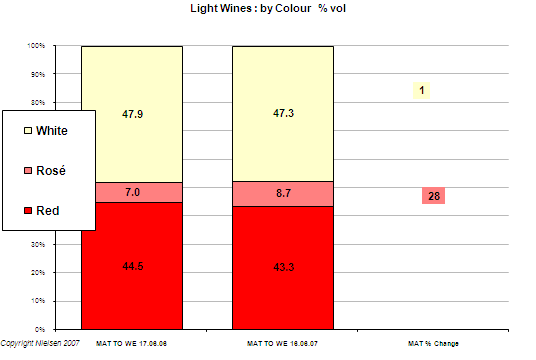|
The
rosé
revival: but is it really good for wine?
One
of the remarkable stories in the drinks business over the last few
years has been the change in fortunes of rosé. In a revival almost as
remarkable and unexpected as the recent about-turn in fortunes for
cider, rosé is now officially ‘hot’, and consumers can’t seem
to get enough of it. The latest AC Nielsen statistics (which measure
what people buy in their supermarket shopping trips) show that rosé
now accounts for 9% of all still wines sold. ‘In a 93m case market,
a contribution of under 9% may not seem much’, says Stewart Blunt of
Nielsen, ‘but consider the impressive growth-rate: for a third year,
rosé wines have achieved growth at a phenomenal rate when seen in
context of what would otherwise be a very flat wine market.’

‘Three
years ago, Rosé was a sedentary part of the market’, continues
Blunt, ‘a subdued 5% of the market dominated by Portugal, and
seemingly held in a time-warp, as the whites and reds set the pace. So
almost 9 out of every 100 bottles now is quite something to write home
about.’
Blunt
points out that the evidence suggests that Californian rosés are
largely responsible for this swing in consumption. ‘The three
leading brands are USA and actually account for 3m cases out of the
current 8.1m cases in pink. In total USA covers 53% of the sector.’
But there’s an interesting twist here. It seems that rosé is
attracting new drinkers to wine.
Top
10 bestselling rose wines in the UK
|
SIERRA VALLEY
|
|
BLOSSOM HILL
|
|
ECHO FALLS
|
|
MATEUS
|
|
JACOBS CREEK
|
|
J P CHENET
|
|
RIVERCREST
|
|
PIAT D'OR
|
|
LA GIOIOSA
|
|
PAUL MASSON
|
‘The
brash new USA rosés tend to be lower in alcohol and higher sugar, and
so it rather suggests that a younger, “less mature” wine-drinker
has been enlisted,’ suggests Blunt. ‘In fact Nielsen’s Household
panel has identified that those households with a penchant for RTDs (
Smirnoff Ice, WKD, Bacardi Breezer, etc.) have added pink wine to
their repertoire.’
However,
it is not just these newcomers who are going for the pink. ‘The
excitement generated has also engaged with the more mature palates
too, it appears,’ says Blunt, ‘as more traditional rosés from
Europe have picked up sales, and as with new world, there are quite a
number of new entries and range extensions to widen the choice. The
fact that the “traditional” rosés as well as the “young ones”
are expanding does suggest that there is a meaningful interest in pink
wine by the drinker – for whatever reasons – be it the aspiration
of summer, be it just fancying a change.’
So
new people are being recruited to the ranks of wine drinkers. This has
to be a good thing, doesn’t it? Yes, but at the same time we have to
think about whether these people are actually being converted to wine
at all: look at the list of the top 10 rosés – this is not a list
that will wildly excite established wine drinkers. It’s wine as
alcopop; wine that resembles, to a degree, the RTDs that this group
have migrated from.
The
big question is whether slightly sweet, fruity rosés are going to act
as a bridge, to attract new drinkers to wine, thus growing the
category. If so, then it’s really good news for wine. If not, then
perhaps we’ll see a migration in the wine industry from traditional
dry styles of table wine towards sweeter, more confected wines that
people find easier to drink on their own.
article published November 2007
Back to top
|

